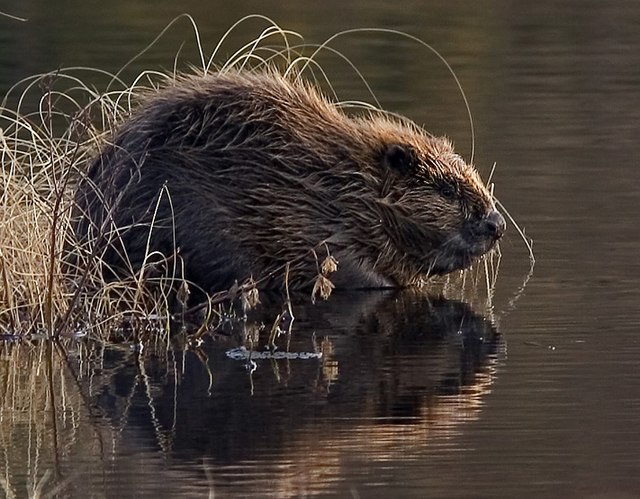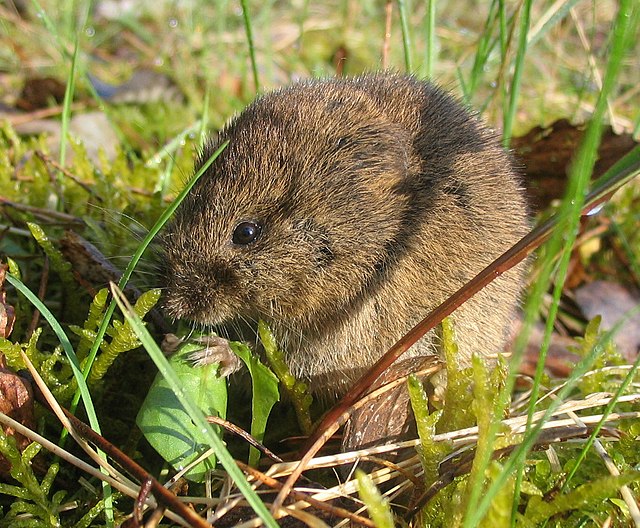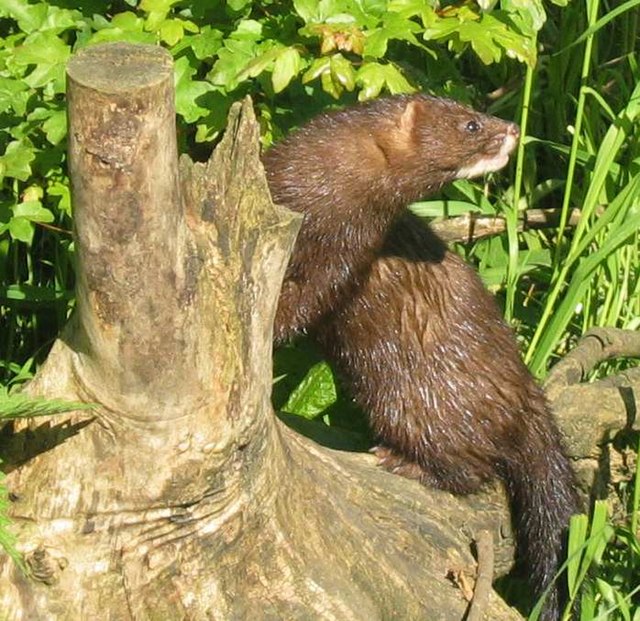Top Qs
Timeline
Chat
Perspective
List of mammals of Hungary
From Wikipedia, the free encyclopedia
Remove ads
This list of mammals of Hungary shows the IUCN Red List status of mammal species occurring in Hungary. Two are endangered, seven are vulnerable, and four are near threatened.
The following tags are used to highlight each species' conservation status as assessed on the respective IUCN Red List published by the International Union for Conservation of Nature:
| EX | Extinct | No reasonable doubt that the last individual has died. |
| EW | Extinct in the wild | Known only to survive in captivity or as a naturalized populations well outside its previous range. |
| CR | Critically endangered | The species is in imminent risk of extinction in the wild. |
| EN | Endangered | The species is facing an extremely high risk of extinction in the wild. |
| VU | Vulnerable | The species is facing a high risk of extinction in the wild. |
| NT | Near threatened | The species does not meet any of the criteria that would categorise it as risking extinction but it is likely to do so in the future. |
| LC | Least concern | There are no current identifiable risks to the species. |
| DD | Data deficient | There is inadequate information to make an assessment of the risks to this species. |
Remove ads
Order: Rodentia (rodents)
Summarize
Perspective






Rodents make up the largest order of mammals, with over 40% of mammalian species. They have two incisors in the upper and lower jaw which grow continually and must be kept short by gnawing. Most rodents are small though the capybara can weigh up to 45 kg (100 lb).
- Suborder: Sciurognathi
- Family: Castoridae (beavers)
- Genus: Castor
- Eurasian beaver, C. fiber LC[1]
- Genus: Castor
- Family: Sciuridae (squirrels)
- Subfamily: Sciurinae
- Tribe: Sciurini
- Genus: Sciurus
- Red squirrel, S. vulgaris LC[2]
- Genus: Sciurus
- Tribe: Sciurini
- Subfamily: Xerinae
- Tribe: Marmotini
- Genus: Spermophilus
- European ground squirrel, Spermophilus citellus VU
- Genus: Spermophilus
- Tribe: Marmotini
- Subfamily: Sciurinae
- Family: Gliridae (dormice)
- Subfamily: Leithiinae
- Genus: Dryomys
- Forest dormouse, Dryomys nitedula NT
- Genus: Muscardinus
- Hazel dormouse, Muscardinus avellanarius NT
- Genus: Dryomys
- Subfamily: Glirinae
- Genus: Glis
- European edible dormouse, Glis glis NT
- Genus: Glis
- Subfamily: Leithiinae
- Family: Dipodidae (jerboas)
- Subfamily: Sicistinae
- Genus: Sicista
- Southern birch mouse, Sicista subtilis NT
- Genus: Sicista
- Subfamily: Sicistinae
- Family: Spalacidae
- Subfamily: Spalacinae
- Genus: Nannospalax
- Lesser mole rat, Nannospalax leucodon VU
- Genus: Nannospalax
- Subfamily: Spalacinae
- Family: Cricetidae
- Subfamily: Cricetinae
- Genus: Cricetus
- European hamster, C. cricetus CR[3]
- Genus: Cricetus
- Subfamily: Arvicolinae
- Genus: Arvicola
- Water vole, Arvicola terrestris LC
- Genus: Clethrionomys
- Bank vole, Clethrionomys glareolus LC
- Genus: Microtus
- Field vole, Microtus agrestis LC
- Common vole, Microtus arvalis LC
- Tundra vole, Microtus oeconomus LC
- European pine vole, Microtus subterraneus LC
- Genus: Ondatra
- Muskrat, Ondatra zibethicus LC introduced
- Genus: Arvicola
- Subfamily: Cricetinae
- Family: Muridae (mice, rats, voles, gerbils, hamsters, etc.)
- Subfamily: Murinae
- Genus: Apodemus
- Striped field mouse, Apodemus agrarius LC
- Yellow-necked mouse, Apodemus flavicollis LC
- Wood mouse, Apodemus sylvaticus LC
- Ural field mouse, Apodemus uralensis LC
- Genus: Micromys
- Harvest mouse, Micromys minutus NT
- Genus: Mus
- House mouse, Mus musculus LC introduced
- Steppe mouse, Mus spicilegus NT
- Genus: Rattus
- Genus: Apodemus
- Subfamily: Murinae
- Family: Castoridae (beavers)
Remove ads
Order: Lagomorpha (lagomorphs)

The lagomorphs comprise two families, Leporidae (hares and rabbits), and Ochotonidae (pikas). Though they can resemble rodents, and were classified as a superfamily in that order until the early 20th century, they have since been considered a separate order. They differ from rodents in a number of physical characteristics, such as having four incisors in the upper jaw rather than two.
- Family: Leporidae (rabbits, hares)
- Genus: Oryctolagus
- European rabbit, O. cuniculus EN[4] introduced
- Genus: Lepus
- European hare, L. europaeus LC[5]
- Genus: Oryctolagus
Remove ads
Order: Erinaceomorpha (hedgehogs and gymnures)
The order Erinaceomorpha contains a single family, Erinaceidae, which comprise the hedgehogs and gymnures. The hedgehogs are easily recognised by their spines while gymnures look more like large rats.
- Family: Erinaceidae (hedgehogs)
- Subfamily: Erinaceinae
- Genus: Erinaceus
- Northern white-breasted hedgehog, E. roumanicus LC
- Genus: Erinaceus
- Subfamily: Erinaceinae
Order: Soricomorpha (shrews, moles, and solenodons)


The Soricomorpha are insectivorous mammals. The shrews and solenodons resemble mice while the moles are stout-bodied burrowers.
- Family: Soricidae (shrews)
- Subfamily: Crocidurinae
- Genus: Crocidura
- Bicolored shrew, Crocidura leucodon LC
- Lesser white-toothed shrew, Crocidura suaveolens LC[6]
- Genus: Crocidura
- Subfamily: Soricinae
- Tribe: Nectogalini
- Genus: Neomys
- Southern water shrew, Neomys anomalus LC
- Eurasian water shrew, Neomys fodiens LC
- Genus: Neomys
- Tribe: Soricini
- Genus: Sorex
- Alpine shrew, Sorex alpinus LC
- Common shrew, Sorex araneus LC
- Eurasian pygmy shrew, Sorex minutus LC
- Genus: Sorex
- Tribe: Nectogalini
- Subfamily: Crocidurinae
- Family: Talpidae (moles)
- Subfamily: Talpinae
- Tribe: Talpini
- Genus: Talpa
- European mole, Talpa europaea LC
- Genus: Talpa
- Tribe: Talpini
- Subfamily: Talpinae
Remove ads
Order: Chiroptera (bats)
Summarize
Perspective





The bats' most distinguishing feature is that their forelimbs are developed as wings, making them the only mammals capable of flight. Bat species account for about 20% of all mammals.
- Family: Vespertilionidae
- Subfamily: Myotinae
- Genus: Myotis
- Bechstein's bat, M. bechsteini NT[7]
- Lesser mouse-eared bat, M. blythii LC[8]
- Brandt's bat, M. brandti LC[9]
- Pond bat, M. dasycneme NT[10]
- Daubenton's bat, M. daubentonii LC[11]
- Geoffroy's bat, M. emarginatus LC[12]
- Greater mouse-eared bat, M. myotis LC[13]
- Whiskered bat, M. mystacinus LC[14]
- Natterer's bat, M. nattereri LC[15]
- Schaub's myotis, Myotis schaubi DD extirpated[16]
- Genus: Myotis
- Subfamily: Vespertilioninae
- Genus: Barbastella
- Western barbastelle, B. barbastellus NT[17]
- Genus: Eptesicus
- Northern bat, Eptesicus nilssoni LC
- Serotine bat, Eptesicus serotinus LC
- Genus: Nyctalus
- Greater noctule bat, N. lasiopterus NT[18]
- Lesser noctule, N. leisleri LC[19]
- Genus: Pipistrellus
- Nathusius' pipistrelle, P. nathusii LC[20]
- Common pipistrelle, P. pipistrellus LC
- Genus: Plecotus
- Grey long-eared bat, P. austriacus NT[21]
- Genus: Barbastella
- Subfamily: Miniopterinae
- Genus: Miniopterus
- Common bent-wing bat, M. schreibersii VU[22]
- Genus: Miniopterus
- Subfamily: Myotinae
- Family: Molossidae
- Genus: Tadarida
- European free-tailed bat, Tadarida teniotis LC
- Genus: Tadarida
- Family: Rhinolophidae
- Subfamily: Rhinolophinae
- Genus: Rhinolophus
- Mediterranean horseshoe bat, R. euryale NT[23]
- Greater horseshoe bat, R. ferrumequinum LC[24]
- Lesser horseshoe bat, R. hipposideros LC[25]
- Genus: Rhinolophus
- Subfamily: Rhinolophinae
Remove ads
Order: Carnivora (carnivorans)



There are over 260 species of carnivorans, the majority of which feed primarily on meat. They have a characteristic skull shape and dentition.
- Suborder: Feliformia
- Family: Felidae (cats)
- Subfamily: Felinae
- Genus: Felis
- European wildcat, F. silvestris LC[26]
- Genus: Lynx
- Eurasian lynx, L. lynx LC[27]
- Carpathian lynx L. l. carpathicus
- Eurasian lynx, L. lynx LC[27]
- Genus: Felis
- Subfamily: Felinae
- Family: Felidae (cats)
- Suborder: Caniformia
- Family: Canidae (dogs, foxes)
- Genus: Vulpes
- Genus: Canis
- Gray wolf, C. lupus LC[29]
- Eurasian wolf, C. l. lupus
- Golden jackal, C. aureus LC[30]
- European jackal, C. a. moreoticus
- Gray wolf, C. lupus LC[29]
- Family: Mustelidae (mustelids)
- Genus: Lutra
- European otter, L. lutra NT[31]
- Genus: Martes
- Beech marten, M. foina LC[32]
- European pine marten, M. martes LC[33]
- Genus: Meles
- European badger, M. meles LC[34]
- Genus: Mustela
- Stoat, M. erminea LC[35]
- Least weasel, M. nivalis LC[36]
- European polecat, M. putorius LC[37]
- Genus: Neogale
- American mink, N. vison LC presence uncertain, introduced[38]
- Genus: Lutra
- Family: Canidae (dogs, foxes)
Remove ads
Order: Perissodactyla (odd-toed ungulates)

The odd-toed ungulates are browsing and grazing mammals. They are usually large to very large, and have relatively simple stomachs and a large middle toe.
- Family: Equidae (horses etc.)
- Genus: Equus
- Wild horse, E. ferus EN reintroduced
- Przewalski's horse, E. f. przewalskii EN reintroduced[39]
- Wild horse, E. ferus EN reintroduced
- Genus: Equus
Order: Artiodactyla (even-toed ungulates)
The even-toed ungulates are ungulates whose weight is borne about equally by the third and fourth toes, rather than mostly or entirely by the third as in perissodactyls. There are about 220 artiodactyl species, including many that are of great economic importance to humans.
Remove ads
Locally extinct
- European bison, Bison bonasus[45]
- European mink, Mustela lutreola[46]
- Brown bear, Ursus arctos[47]
See also
References
External links
Wikiwand - on
Seamless Wikipedia browsing. On steroids.
Remove ads